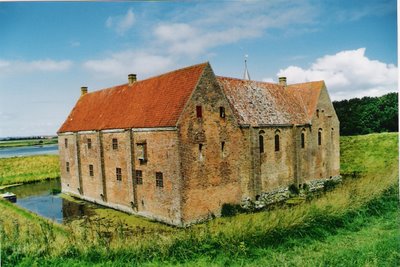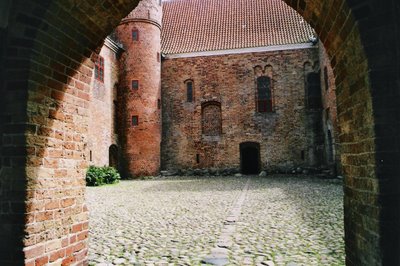
Spøttrup, a bishop's castle, North Jutland
The chancellor started the banquet by saying grace, and later the curate read from the Holy Scripture. During dinner was entertainment by folk musicians with fifes and drums and some appeareances by the jester. It was a principal concept to let music and other cultural experiences accompany a high gastronomic cuisine. The ten-course dinner was served in several dining rooms in the hishop's house. The bishop himself was dining in the biggest room ('borgstuen') together with his highly trusted staff and special guests. Only the bishop was served every course on a daily basis, but on a big festival all courses were shared by everyone.
Table cloth in several layers covered the tables in the dining rooms. The service were mainly ceramics or wood and eventual pewter, and the cutlery were knives, spoons and the fingers, since the fork had not yet arrived. Glass ware was seldom in use by the Norse Tables, as people had a bad habit of crushing the valuable glass after drinking. A cupbearer, called the 'Kredens', had the job to cut meat and bread - and also to taste food and drink, before it was served to the bishop and the party. A comprehensive domestic staff was present at a ceremony like this; they were young men from the nobility. This was a part of their good breeding in order to be able to serve Royal visitors and other VIPs in the most distinguished way in their own manor one day.
The water bowl for dipping hands at some special parties today is not a new invention. During and after meals servants carried basins with rose water and towels for the party to have their hands washed and dried. Between meals several festive sights were shown to the guests. Servants carried along magnificent show dishes, large decorated centrepieces with peacocks and other animals, together with decorated patés with ingenious lids, indicating the contents.
Example of a menu:
1) spit-roast leg of lamb (spices: thyme, sage, parsley, cinnamon, garlic, wine vinegar, salt)
2) wine soup (egg yolks, sugar, grated nutmeg, saffron, white wine, a stick of cinnamon, grated ginger, butter roasted bread squares)
3) boiled beed (salt, vinegar, chopped sage)
4) poched eggs
5) fried venison tenderloin (fresh ginger, pepper, salt, butter, venisonstock, white bread without crust)
6) boiled pike ( Hamburg parsley, parsley, white bread without crust, white wine, white vinegar, fresh grated ginger, white pepper, crushed cinnamon, sugar, cloves and saffron)
7) paté venison (deer shoulder, fat, salt, black pepper, fresh ginger)
8) fried pigeons ( butter, vinegar, red wine, fresh ginger, a stick of cinnamon, black pepper, sugar, salt, saffron, white bread without crust)
9) fresh cheese
10) fig dessert ( dried figs, evt. mead, white bread without crust, almonds, currants, fresh grated ginger, a stick of cinnamon, sugar, saffron, whipped cream)
For some courses were served vegetables, i.e. all sorts of root and leguminous fruits and cabbage, and leek, onion, garlic. Some of the bread, served for religious feasts were small 'sacred' breads.

Spøttrup, a bishop's castle, North Jutland
Herbs and Spices.
Common medicine plants in Denmark in the Middle Ages were angelica, parsley, chives, horse-radish, Danish cumin, mustard, dill, fennel, cress, dandelion etc. Some other herbs, used to grow in warmer climate, arrived with the monks, who cultivated them in the closter gardens from about 1100s; they were rosemary, basil, lavender, hyssop, savory, marjoram, oregano, currant, sage, thyme, borage, curled mint, peppermint and lovage. The Oriental spices arrived to the North via the Hansa. Black pepper seems to have been most widely spread. Bachelors worked for the Hansa selling pepper and other spices, and they were not allowed to marry. From this custom origins the Danish expression 'Pebersvend' (Pepper Boy). The word Pebersvend is still in use in Denmark, and if a guy is not yet married on his 30th birthday, then his presents might still be some fine pepper pots.
All these herbs and spices are mentioned in the Danish physician Henrik Harpestræng's herbal book, but there is no doubt that only very well-off people could afford such luxury. In the Middle Ages pepper and other Oriental spices were very precious, and spices like saffron , cloves, cinnamon, nutmeg, mace, cardamom, ginger etc. were imported to Denmark in a limited quantity. In the Danish king Christoffer III of Bayern's court accounts from 1447 is told about some purchase of precious spices for a festival.
The doctors at court were very important. From medieval courts at Richard II of England and Charles the Bold, Duke of Burgundy, is described how the doctor at court had to take care of the prince and his family's good health.The doctor and the cooks prepared the food together, and the choice of medicinal herbs played a big part, since they contributed to give the course an intentional balance. During dinner the doctor stood by the prince's table, where he gave instructions as to the proper composition concerning the well-being of the prince.
Theriak.
But there were also other reasons for taking care of the prince and other important persons by the dinner table. A serious problem was the safety around food and drinks, as the period was known for poisoning royalties and other significant people. The 'Kredens' /cupbearer had to taste all food and drinks, before they were served. A preventive means, an antidote, Theriak, was placed upon the table in a fine vessel, often formed like a ship and made in silver, but also the salt and pepper were being watched over. The salt vessel had to be covered, and between meals it was kept in the 'Silver Chamber'.
Theriak was an Arabic invention from the late 1100s, which is also described in the Danish physician Henrik Smith's herbal book. It consisted of birthwort (Aristolochia) , gentian, laurel, the best and noblest myrrh and honey. The original Arabic theriak contained snake, but this was replaced by crushed powder from the strong and poisonous herb birthwort. (Danish name: slangerod =snake's root) It was also a common advise to use the powder of the root against snake bites and as an emetic. In the morning it was recommended to take theriak in the size of a hazelnut. This would protect humans from plague etc., and it was said in general to be suitable for both man and beast.
Medicine puré:
Some medicine puré mentioned in a medical adviser like 'Conserva' and 'Electuarum' and 'Latverge' (German) showed to be a forerunner for today's assorted chocolates and other goodies. In Queen Christina's court accounts from 1510-12 was bought cinnamon- and ginger candy, almond- and anis candy etc. Henrik Smith's collection of recipes from 1546 gave common people the opportunity to make these goodies themselves. A medicine puré could be barley groat puré with figs and raisins, cooked with water into a consistency like a thick syrup, and when cool, sprayed with grounded cinnamon - and maybe served with crême fraiche!
Source: Bente Leed: Danskernes mad i middelalderen, 1999.
photo Spøttrup: grethe bachmann
No comments:
Post a Comment